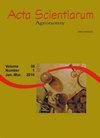Genetic parameters and gains with the selection of fig tree genotypes
IF 1.2
4区 农林科学
Q3 AGRONOMY
引用次数: 1
Abstract
Fig tree (Ficus carica L., Moraceae), which originated in the Mediterranean Basin, is one of the many fruit trees grown in Brazil, with ‘Roxo-de-Valinhos’ being the exclusively used cultivar. In this context, research aimed at the improvement of this species to develop highly resistant and adaptable cultivars is paramount. Thus, the present study aimed to maintain fig accessions in an in vivo active germplasm bank (AGB) at the Faculty of Engineering of Ilha Solteira (FEIS), São Paulo State University (UNESP), as well as to characterize the agronomic traits of these accessions based on quantitative descriptors of genetic parameters and observe gains with the selection of specific genotypes to illustrate the AGB in terms of genetic variability. A total of 36 F. carica genotypes were evaluated in the field at the Teaching, Research and Extension Farm (FEPE) of the FEIS, UNESP. Qualitative traits, fruit parameters (e.g., insertion of the first fruit, fruit stalk length, fruit length, fruit diameter, and average fruit mass), and accumulated plant dry mass were measured. In addition, genetic parameters, variance components, and descriptive statistics, including genetic and environmental variances, heritability and average heritability of clones, coefficients of genotypic and environmental variation and their ratio ( ), general average, and selection gain, were evaluated. The selected fig tree accessions showed genetic variability in the assessed traits, exhibiting good heritability and achieving selection gains. For instance, the first 10 classified clones exhibited a heritability of 80.2% and achieved a selection gain of 98% for accumulated plant dry mass. Therefore, the maintenance of in vivo AGBs allows agronomic studies, offering promising results for continuing the breeding programs and preserving the genetic variability of species.无花果树基因型选择的遗传参数和增益
无花果树(Ficus carica L.,桑科)起源于地中海盆地,是巴西种植的许多果树之一,“Roxo-de-Valinhos”是唯一使用的品种。在此背景下,对该物种进行改良,开发高抗性和适应性的品种是至关重要的。因此,本研究旨在维持圣保罗州立大学(UNESP) Ilha Solteira工程学院(FEIS)的无花果在体内活性种质资源库(AGB),并基于遗传参数的定量描述来表征这些材料的农艺性状,并观察特定基因型选择的增益,以说明AGB的遗传变异。在UNESP FEIS的教学、研究和推广农场(FEPE)实地评估了36个卡里卡菌基因型。测定了种质性状、果实参数(如插穗、果实柄长、果实长、果实直径、平均果实质量)和植株累积干质量。此外,还对遗传参数、方差组成、描述统计进行了评价,包括遗传和环境方差、无性系遗传力和平均遗传力、基因型和环境变异系数及其比值()、一般平均、选择增益等。所选无花果树材料在评价性状上表现出遗传变异,表现出良好的遗传力,实现了选择增益。例如,前10个分类无性系的遗传力为80.2%,累积植株干质量的选择增益为98%。因此,维持体内agb可以进行农艺研究,为继续育种计划和保护物种的遗传变异性提供有希望的结果。
本文章由计算机程序翻译,如有差异,请以英文原文为准。
求助全文
约1分钟内获得全文
求助全文
来源期刊

Acta Scientiarum. Agronomy.
Agricultural and Biological Sciences-Agronomy and Crop Science
CiteScore
2.40
自引率
0.00%
发文量
45
审稿时长
>12 weeks
期刊介绍:
The journal publishes original articles in all areas of Agronomy, including soil sciences, agricultural entomology, soil fertility and manuring, soil physics, physiology of cultivated plants, phytopathology, phyto-health, phytotechny, genesis, morphology and soil classification, management and conservation of soil, integrated management of plant pests, vegetal improvement, agricultural microbiology, agricultural parasitology, production and processing of seeds.
 求助内容:
求助内容: 应助结果提醒方式:
应助结果提醒方式:


